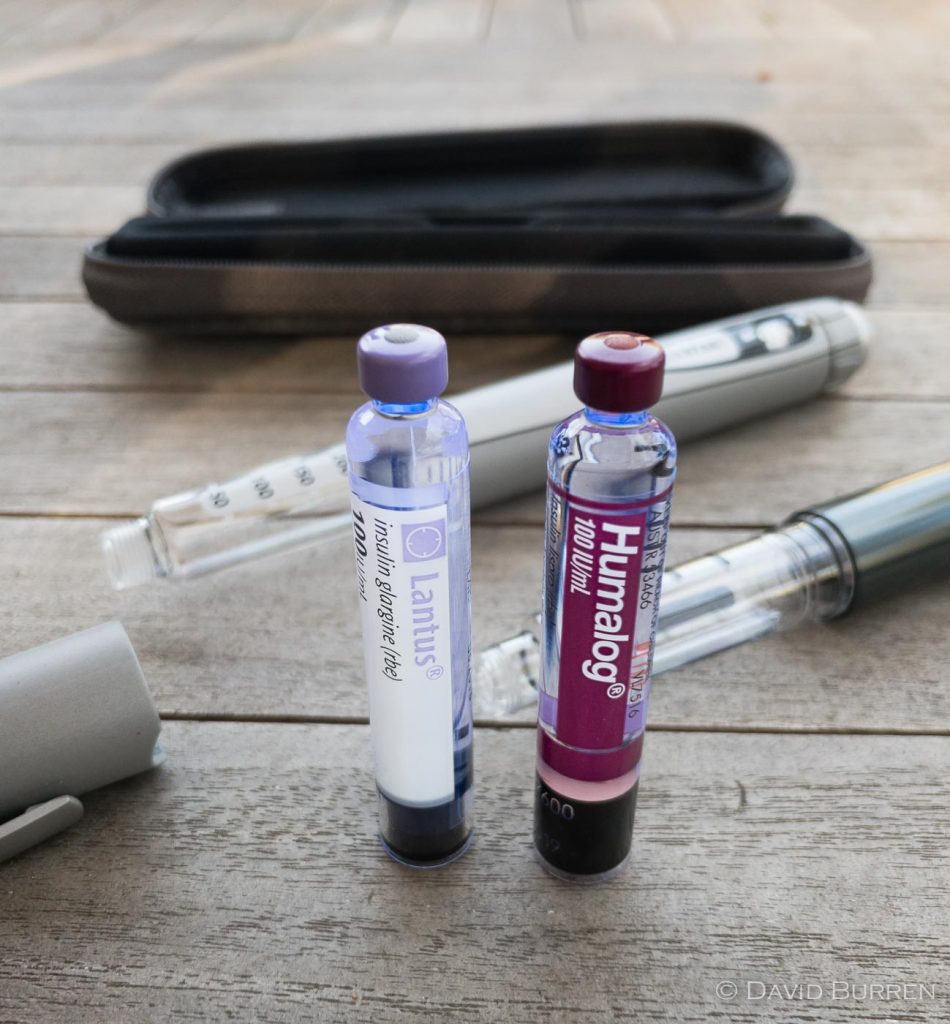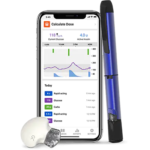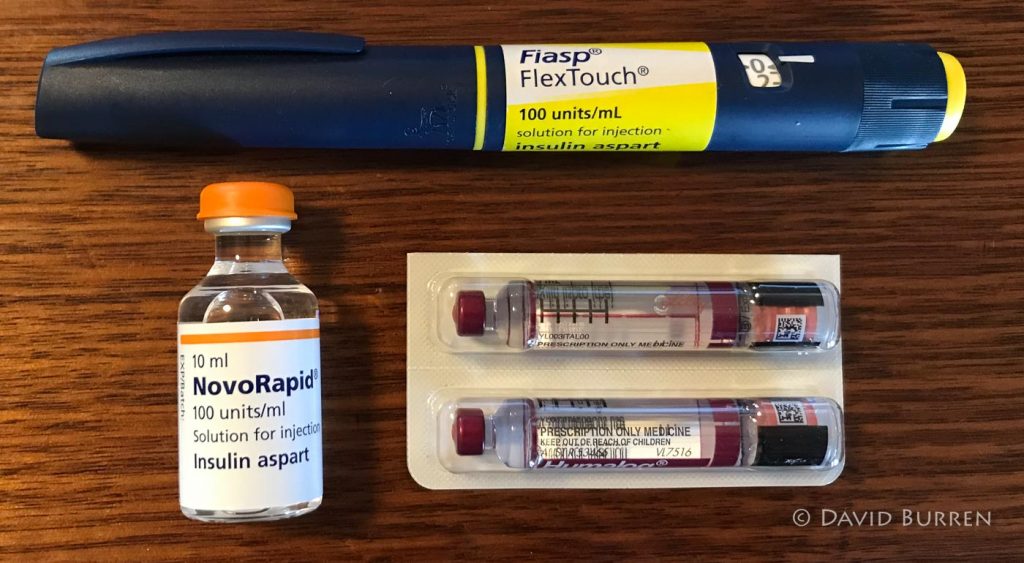This article is a general education one, but it’s also reference material for an upcoming discussion on insulin availability.
In Australia most insulins have been available in up to three formats:
- 10 mL vials. Traditionally used for syringe injections and filling pumps.
- 3 mL pen cartridges. Put into pens for injections. Some people also use these to fill pumps.
- 3 mL disposable pens. Each has a pen cartridge but encased in a single-use plastic pen.
I started off with syringes and vials, and then started using pens before they had the single-use disposable ones. So it’s still surprising to me when I come across people who assume that it only comes in the disposable pens.
The format the insulin is supplied as is specified on the prescription. So it’s quite possible that some people were given a prescription from their doctor for one format and have never realised that they have options when they’re getting their next script.
These formats are used for some of the long-acting insulins as well as the rapid-acting ones:
| U100 Insulin | Make | 10 mL vial | 3 mL pen cartridge | 3 mL single-use pens |
|---|---|---|---|---|
| Apidra | Sanofi | ✓ | Penfill | SoloStar |
| Humalog | Lilly | ✓ | ✓ | KwikPen |
| NovoRapid | Novo | ✓ | Penfill | FlexPen |
| Fiasp | Novo | ✓ | (Penfill but never got added to PBS) | FlexTouch |
| Lantus/Optisulin | Sanofi | ✓ | SoloStar | |
| Levemir | Novo | Penfill | FlexPen | |
| Actrapid | Novo | ✓ | Penfill |
Over the years there have been various models of the pens that accept cartridges.

These seem to be the current selection:
| Make | Pen | Dose increment | Max dose | Features |
|---|---|---|---|---|
| Novo | NovoPen 4 | 1 U | 60 U | |
| Novo | NovoPen Echo | 0.5 U | 30 U | Display of last dose and time. |
| Sanofi | AllStar Pro | 1 U | 80 U | |
| Sanofi | JuniorStar | 0.5 U | ||
| Lilly | HumaPen Savvio | 1 U | 60 U |
Each of these are available in several different colours (also many people accessorise them with decals). It can be useful to have each of your insulins in a different colour pen.
There are some other models not yet available in Australia, but they’re not important in this conversation.
 One other that is available here is the Companion InPen from Medtronic. That takes either NovoRapid or Humalog cartridges (there are two models) and links to an app on your phone that integrates with a Medtronic CGM to give you dosing advice as well as tracking what was actually delivered.
One other that is available here is the Companion InPen from Medtronic. That takes either NovoRapid or Humalog cartridges (there are two models) and links to an app on your phone that integrates with a Medtronic CGM to give you dosing advice as well as tracking what was actually delivered.
Where to get re-usable pens
Usually a pharmacy can supply you with a pen (at no charge) so you can use the insulin cartridges they dispense to you. The insulin companies give them pens for this reason.
You can also phone the companies directly and ask for particular pens. They’ll usually send you at least two (again, at no charge) if you ask. This way you can get the particular pen models and colours that you want, rather than being limited to the one the pharmacy had in the cupboard. It’s also the only way to get the NovoPen Echo (unless your DE can get one for you).
The InPen does cost $600, and the battery is only rated for a year’s use. I think the expectation there is that health insurance would help, although it’s not classed as a prosthesis in the way pumps are.
Why choose each format?
Each of the insulin containers has its place, although we end up choosing the one that suits us. I’m going to list here what I see as issues with each, although of course you may have found other pros and cons for you. I’ll start by considering the use-cases.
MDI injections
 If injections are your regular delivery mechanism, either single-use or re-usable pens are usually a lot more convenient than syringes. I started out with syringes and 10 mL vials, but after I discovered pens I didn’t look back.
If injections are your regular delivery mechanism, either single-use or re-usable pens are usually a lot more convenient than syringes. I started out with syringes and 10 mL vials, but after I discovered pens I didn’t look back.
 A re-usable pen that can dose in 0.5U increments is very useful for people using small doses. All the single-use pens only do 1U increments.
A re-usable pen that can dose in 0.5U increments is very useful for people using small doses. All the single-use pens only do 1U increments.
Filling pumps from vials

The default instructions that come with pumps assume we’re going to fill them from 10 mL vials. They often come with “transfer adapters” neatly sized to fit the head of the vials. The Tandem and Omnipod pumps involve a two-step process, using a supplied syringe and needle to extract the insulin and then inject into the reservoir.
But just like when using syringes, the filling process involves using the reservoir-plus-adapter as essentially a big syringe.
We first have to inject the equivalent volume of air into the vial to match the volume of insulin we’re going to take out (to avoid creating a vacuum inside the vial).
We then consolidate any air bubbles in the “syringe” up to the top, push that air into the vial, and pull the right amount of insulin back. The concept is fairly straight forward.
Filling pumps from pens
 It is however quite possible to fill a pump from a pen. The reservoir’s transfer adapter can connect to the pen just like a needle. Because the rubber area on the end of the pen is smaller than that on a vial cap, you do need to be careful to ensure the adapter’s needle goes through the rubber and doesn’t just blunted on the metal surrounds. The Medtronic adapter can be trickier than the other brands, as its needle is often off-centre.
It is however quite possible to fill a pump from a pen. The reservoir’s transfer adapter can connect to the pen just like a needle. Because the rubber area on the end of the pen is smaller than that on a vial cap, you do need to be careful to ensure the adapter’s needle goes through the rubber and doesn’t just blunted on the metal surrounds. The Medtronic adapter can be trickier than the other brands, as its needle is often off-centre.
You don’t need to first inject air into the pen. You can even advance the pen to push insulin into the reservoir. This can also simplify things when you’ve emptied an insulin container but have only half-filled the reservoir: there’s no hassle about having to inject the right amount of air into the next container.
If you’re careful, you can fill the pump from pens, then carry a pen with some needles in case you need it for emergency use. All from a single prescription.
Filling pumps from pen cartridges
This is very similar to using a pen, but I’m referring to just using the cartridge without a pen.
If we draw the insulin out (using the syringe handle) the rubber stopper will advance by itself. If we push down on the rubber stopper (e.g. with a pencil) we can instead push insulin into the reservoir.
I tend to push insulin down into the reservoir, then consolidate any bubbles and push them up back into the cartridge. Then push insulin back into the reservoir to top it up. By pushing and never pulling, I think that contributes to not introducing many bubbles into my reservoirs.
I’ll often have a spare pen in my travel kit for emergencies, but usually don’t load the cartridges into the pen.
Which format do I get?
There are multiple levels of answer to this.
If everything else is equal, I’ll get the one I want. Usually for me the 3 mL cartridges are most convenient, even for filling pumps.
But the bottom line is that I’ll use whatever I can get.
- If I have vials I can inject from those using syringes. And I can fill pumps with them.
- If I have pen cartridges I can drop those into a pen to inject. And I can fill pumps with them.
- If I have single-use pens I can inject from those, and fill pumps. Or I can convert them to cartridge format.
When Fiasp wasn’t available in Penfill format that was frustrating, but wasn’t a show-stopper. Having access to the insulin in any format was the important thing.
I’m currently using Lyumjev which I brought from Europe. It’s in vials which is the least-convenient format for me. But it’s all I have, and I find a way.
Hopefully you can find the best tools to suit your own insulin use. Knowing what your options are is a start!


Hi David,
Is the use of past tense in the statement “When Fiasp wasn’t available in Penfill format that was frustrating” intentional? I wasn’t aware of a change to penfills being available, and the lack of them is still a frustration to many. Have I missed something, or is it simply that the frustration is in the past for you, because you no longer use Fiasp?
Good catch. See today’s article…
I noticed can obtain the more recent Novo pens(Novopen 5, Novopen 6 and Novo Echo Plus) from overseas:
ie https://www.desertcart.com.au/products/415430328-novopen-echo-plus-insulin-pen
The Novopen 5 has memory same as regular Echo but bigger dosing, missing 0.5unit dosing. Would be good to add max dose (ie 30 or 60 units) to above table.
The Novopen 6 and Echo Plus add NFC integration to transmit dosage info with various apps(ie LibreLink)
One annoying thing presently with the integration is that priming doses when starting a cartridge get included too. Also Novo recommendations priming 0.5units for each needle change so get that as well.
Data transfer via NFC is maybe a step beyond no transfer, but it seems vastly inferior to Bluetooth. Bluetooth does use more battery power, but it transfers automatically, without you having to remember to scan the pen with your phone. I’ve been watching a few of these products overseas (and played with some of them when I was at a conference in Berlin recently).
Using NFC Novo is claiming 4-5 years lifespan for the Echo Plus and Novopen 6.
Supposedly it holds last 800 doses, so they plan to only sync with smartphone occasionally.
I can see 3 uses for the smart pens over ordinary pens: double dosing, missed dosing and logging of doses.
The double dosing prevention is by far most important reason. This already looks well handled by the memory pens(Echo and Novopen 5), is simple to check for by clicking the pen.
Missed dosing requires something else, need to somehow get a diabetics attention they have not had any injections recently. Most obvious thing would be to display on a watch or CGM software the output time of the last dose. As you said this is where Bluetooth would be far superior compared to NFC.
Finally synchronisation/dose logging, this is for self or health care team analysis at a later date. This one looks like the only real benefit of the Echo Plus/Novopen 6 over the current Echo/Novopen 5.
(See Echo Plus manual here: https://www.novonordisk.com/content/dam/nncorp/global/en/our-products/pdf/instructions-for-use/novopen-echo-plus/Novopen-echo-plus-IR.pdf)
I saw when Tresiba was given Auspar by the TGA, Novo was asked what usage percentage the different form factors have.
They quoted a study which said for Australia overall 75% precriptions are for disposable pens, 23% penfill cartridges and 2% vials.
Considering long acting insulin only, it was 85.7% disposable, 13.5% penfill and 0.8% vials.
The only explanation I can see for domination of disposable pens is they have slightly higher retail price than the others. The sales reps push disposables very aggressively to doctors as the best solution for diabetics.. Possibly the sales reps are paid commision by total $ sales.
The disposables are by far the worst form factor as far as the environment is concerned